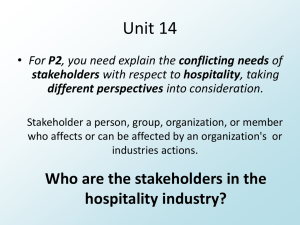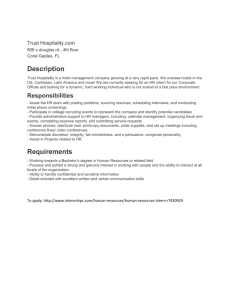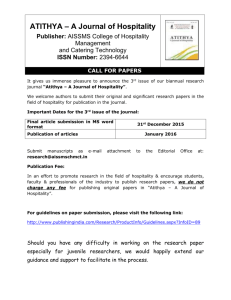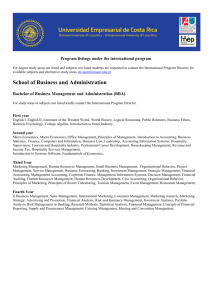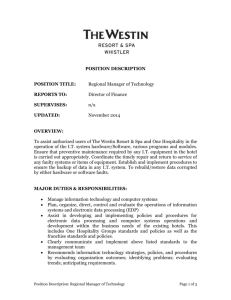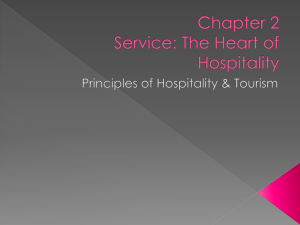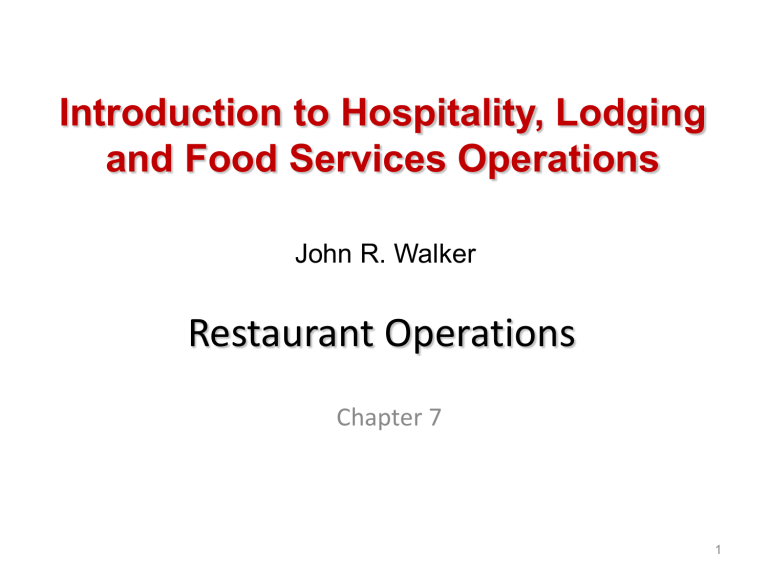
Introduction to Hospitality, Lodging
and Food Services Operations
John R. Walker
Restaurant Operations
Chapter 7
Introduction to Hospitality, 6e and Introduction to
Hospitality Management, 4e - Walker
© 2013 by Pearson Higher Education,
1 Inc
Upper Saddle River, New Jersey 07458 • All Rights Reserved
Front of the House
• Includes anyone with guest contact from the
hostess to the bus person
• Curbside appeal: Keeping the restaurant looking
attractive and welcoming
• Restaurant is run by a General Manager, or
restaurant manager
• Depending on size and sales volume, there may
be more managers with other responsibilities
• Managers should all be cross-trained to relieve
each other
Introduction to Hospitality, 6e and Introduction to
Hospitality Management, 4e - Walker
© 2013 by Pearson Higher Education,
2 Inc
Upper Saddle River, New Jersey 07458 • All Rights Reserved
Restaurant Organizational Chart
Figure 7-1
Introduction to Hospitality, 6e and Introduction to
Hospitality Management, 4e - Walker
© 2013 by Pearson Higher Education,
3 Inc
Upper Saddle River, New Jersey 07458 • All Rights Reserved
Front of the House
• The hostess, host, or greeter is responsible
for greeting the guests and the rotation of
arriving guests among sections or stations
• Servers introduce themselves and offer a
variety of beverages and/or specials, and
invite guests to select from the menu
–This is known as suggestive selling
Introduction to Hospitality, 6e and Introduction to
Hospitality Management, 4e - Walker
© 2013 by Pearson Higher Education,
4 Inc
Upper Saddle River, New Jersey 07458 • All Rights Reserved
Front of the House
• Seven steps of table service:
–
–
–
–
–
–
–
Greet guests
Introduce and suggestively sell beverages
Suggest appetizers
Take orders
Check back after two bites
Sell another drink
Sell dessert and suggest after dinner drinks
• Servers are also expected to be NCO (neat, clean,
and organized)
Introduction to Hospitality, 6e and Introduction to
Hospitality Management, 4e - Walker
© 2013 by Pearson Higher Education,
5 Inc
Upper Saddle River, New Jersey 07458 • All Rights Reserved
Restaurant Forecasting
• Formulating a budget that projects sales and
costs for a year on a weekly and monthly basis
• Forecasting restaurant sales has 2
components: Guest counts or covers and the
average guest check
• Guest counts or covers: The number of guests
patronizing the restaurant over a given time
period
• Average guest check: Calculated by dividing
total sales by the number of guests
Introduction to Hospitality, 6e and Introduction to
Hospitality Management, 4e - Walker
© 2013 by Pearson Higher Education,
6 Inc
Upper Saddle River, New Jersey 07458 • All Rights Reserved
Restaurant Forecasting
• The year is divided into twelve 28-day periods
and one 29-day period.
• These 13 accounting periods are used to
better compare one period to another
Introduction to Hospitality, 6e and Introduction to
Hospitality Management, 4e - Walker
© 2013 by Pearson Higher Education,
7 Inc
Upper Saddle River, New Jersey 07458 • All Rights Reserved
Restaurant Forecasting
Introduction to Hospitality, 6e and Introduction to
Hospitality Management, 4e - Walker
© 2013 by Pearson Higher Education,
8 Inc
Upper Saddle River, New Jersey 07458 • All Rights Reserved
Production Forecasting
Production
Forecasting
Introduction to Hospitality, 6e and Introduction to
Hospitality Management, 4e - Walker
© 2013 by Pearson Higher Education, Inc
Upper Saddle River, New Jersey 07458 • All Rights Reserved
Production Demand
Overproduction
Production
Demand
Introduction to Hospitality, 6e and Introduction to
Hospitality Management, 4e - Walker
Underproduction
© 2013 by Pearson Higher Education, Inc
Upper Saddle River, New Jersey 07458 • All Rights Reserved
Historical Records
Date and Day of the Week
Meal or Hour of Service
Notation of Special Event, Holiday & Weather Conditions
Food Items Prepared
Quantity of Each Item Prepared
Quantity of Each Item Served
Introduction to Hospitality, 6e and Introduction to
Hospitality Management, 4e - Walker
© 2013 by Pearson Higher Education, Inc
Upper Saddle River, New Jersey 07458 • All Rights Reserved
Service
• Today, quality is more important to all
restaurant guest in every country
• Quality is often the one area that sets
one restaurant apart from its
competition
• A new standard in restaurant service has
emerged; a less formal yet professional
approach is preferred by restaurant
diners
Introduction to Hospitality, 6e and Introduction to
Hospitality Management, 4e - Walker
© 2013 by Pearson Higher Education,
12 Inc
Upper Saddle River, New Jersey 07458 • All Rights Reserved
Service Quality
Introduction to Hospitality, 6e and Introduction to
Hospitality Management, 4e - Walker
© 2013 by Pearson Higher Education,
13 Inc
Upper Saddle River, New Jersey 07458 • All Rights Reserved
Introduction to Hospitality, 6e and Introduction to
Hospitality Management, 4e - Walker
© 2013 by Pearson Higher Education,
14 Inc
Upper Saddle River, New Jersey 07458 • All Rights Reserved
Quality in the Foodservice System
Quality is not a program; it is an approach to business.
Quality is defined by the customer through his or her satisfaction.
Quality is aimed at performance excellence; anything less is an improvement
opportunity.
Quality increases customer satisfaction, reduces cycle times and costs, and
eliminates errors and rework.
Introduction to Hospitality, 6e and Introduction to
Hospitality Management, 4e - Walker
© 2013 by Pearson Higher Education, Inc
Upper Saddle River, New Jersey 07458 • All Rights Reserved
Approaches to Quality
Total
Quality
Management
Quality
Assurance
Kaizen
Continuous
Quality
Improvement
Reengineering
Introduction to Hospitality, 6e and Introduction to
Hospitality Management, 4e - Walker
Six Sigma
Lean
Theory of
Constraints
© 2013 by Pearson Higher Education, Inc
Upper Saddle River, New Jersey 07458 • All Rights Reserved
Components of TQM
Intense focus on the customer.
Concern for continual improvement
Focus on process
Improvement in quality of everything the company does
Accurate Measurement
Empowerment of Employees
Introduction to Hospitality, 6e and Introduction to
Hospitality Management, 4e - Walker
© 2013 by Pearson Higher Education, Inc
Upper Saddle River, New Jersey 07458 • All Rights Reserved
Quality Standards
ISO 9000
Professional Practices in
College & University
Foodservice
Quality
Standards
Introduction to Hospitality, 6e and Introduction to
Hospitality Management, 4e - Walker
Keys to Excellence
The Joint
Commission
© 2013 by Pearson Higher Education, Inc
Upper Saddle River, New Jersey 07458 • All Rights Reserved
ISO 9000 Standards
Customer
Focus
Leadership
Systems
Approach to
Management
Involvement
Of People
Continual
Improvement
Introduction to Hospitality, 6e and Introduction to
Hospitality Management, 4e - Walker
Factual
Approach to
Decision
Making
Process
Approach
Mutually
Beneficial
Supplier
Relations
© 2013 by Pearson Higher Education, Inc
Upper Saddle River, New Jersey 07458 • All Rights Reserved
Malcolm Baldrige National Quality Award
Strategic
Planning
Leadership
Human
Resource
Focus
Process
Management
Introduction to Hospitality, 6e and Introduction to
Hospitality Management, 4e - Walker
Measurement,
Analysis &
Knowledge
Management
Customer
& Market
Focus
Business
Results
© 2013 by Pearson Higher Education, Inc
Upper Saddle River, New Jersey 07458 • All Rights Reserved
Types of Restaurant Service
• American Service:
Food is placed onto
plates in the kitchen,
carried into the dining
room, and served to
guests
– Restaurants in the
United States,
Canada, and many
other parts of the
world all use
American service
Introduction to Hospitality, 6e and Introduction to
Hospitality Management, 4e - Walker
© 2013 by Pearson Higher Education,
21 Inc
Upper Saddle River, New Jersey 07458 • All Rights Reserved
Introduction to Hospitality, 6e and Introduction to
Hospitality Management, 4e - Walker
© 2013 by Pearson Higher Education,
22 Inc
Upper Saddle River, New Jersey 07458 • All Rights Reserved
Suggestive Selling
• Suggestive selling is an important tool to
increase food and beverage sales
• Guests are not usually offended with
suggestive selling techniques
• Through training, servers become sellers
• Guests will be more likely to be receptive
to suggestions from competent servers
(Cm Ylmz)
Introduction to Hospitality, 6e and Introduction to
Hospitality Management, 4e - Walker
© 2013 by Pearson Higher Education,
23 Inc
Upper Saddle River, New Jersey 07458 • All Rights Reserved
Front of the House Restaurant Systems
• Point-of-sale (POS) systems:
–Used to track food and beverage
charges and other retail charges that
may occur at a hotel or restaurant
• Kitchen Display Systems:
–Printers in the kitchen are replaced with
video monitors and presents orders to
kitchen associates along with
information on how long orders are
taking to be prepared
Introduction to Hospitality, 6e and Introduction to
Hospitality Management, 4e - Walker
© 2013 by Pearson Higher Education,
24 Inc
Upper Saddle River, New Jersey 07458 • All Rights Reserved
Front of the House Restaurant Systems
• Guest Services Solutions:
–Applications that are designed to help a
restaurateur develop a dining
relationship with guests
–Applications include a frequent-diner
management program, delivery
management with caller ID interface,
and guest accounts receivable to
manage home accounts and gift
certificate management
Introduction to Hospitality, 6e and Introduction to
Hospitality Management, 4e - Walker
© 2013 by Pearson Higher Education,
25 Inc
Upper Saddle River, New Jersey 07458 • All Rights Reserved
Back of the House Restaurant Systems
• Includes inventory control, food costing, labor
management, and financial reporting features
• Wireless POS Systems:
– Allows the servers to use a handheld personal
digital assistant to send orders to the kitchen
• Labor Management:
– Includes a human resources module to track
hiring, employee personal information, vacation,
security privileges, tax status, availability, and any
other information pertinent (concerning) to
employees working at a restaurant
Introduction to Hospitality, 6e and Introduction to
Hospitality Management, 4e - Walker
© 2013 by Pearson Higher Education,
26 Inc
Upper Saddle River, New Jersey 07458 • All Rights Reserved
Back of the House Restaurant Systems
• Financial Reporting:
– Posts data into a relational database located on the
central server
– The restaurant manager uses these data for
reporting and decision making, profit and loss
reports, budget variances, end-of-day reports, and
other financial reports are generated
• Personal Digital Assistants:
– Help hospitality businesses stay effective and
efficient by improving time management and
helping with faster service
Introduction to Hospitality, 6e and Introduction to
Hospitality Management, 4e - Walker
© 2013 by Pearson Higher Education,
27 Inc
Upper Saddle River, New Jersey 07458 • All Rights Reserved
Food Production
• Based on expected volume of business
• The sales from the previous year gives a
good indication of the expected volume
and a breakdown of the number of sales
for each menu item
• The kitchen manager checks the head
line cook’s order, which will bring the
prep area up to the par stock for
prepared items
• Prep work is done prior to service times
Introduction to Hospitality, 6e and Introduction to
Hospitality Management, 4e - Walker
© 2013 by Pearson Higher Education,
28 Inc
Upper Saddle River, New Jersey 07458 • All Rights Reserved
Food Production
• The cooking line is the most important
part
• The size of the kitchen and its equipment
are designed according to the sales
forecast for the restaurant and the menu
• The kitchen is also set up according to
what the customers prefer and order
most frequently
Introduction to Hospitality, 6e and Introduction to
Hospitality Management, 4e - Walker
© 2013 by Pearson Higher Education,
29 Inc
Upper Saddle River, New Jersey 07458 • All Rights Reserved
Kitchen/Food Production
• Staffing and Scheduling: Crucial for
the successful running of a kitchen
• Training and Development:
Implementing a comprehensive
training program is vital in the
kitchen, due to a high turnover rate
Introduction to Hospitality, 6e and Introduction to
Hospitality Management, 4e - Walker
© 2013 by Pearson Higher Education,
30 Inc
Upper Saddle River, New Jersey 07458 • All Rights Reserved
Kitchen/Food Production
• Production Procedures: Relates directly
to the recipes on the menu and
amount of product on hand to
produce the menu
• Production sheets:
–Count the product on hand (par levels).
–Determine production level.
Introduction to Hospitality, 6e and Introduction to
Hospitality Management, 4e - Walker
© 2013 by Pearson Higher Education,
31 Inc
Upper Saddle River, New Jersey 07458 • All Rights Reserved
Kitchen/Food Production
• Management involvement and follow-up:
–Management should know first-hand
what is going on in the back of the
house
–As management spends more time in
the kitchen, more knowledge is gained,
more confidence is acquired, and more
respect is earned
Introduction to Hospitality, 6e and Introduction to
Hospitality Management, 4e - Walker
© 2013 by Pearson Higher Education,
32 Inc
Upper Saddle River, New Jersey 07458 • All Rights Reserved
Production Schedule Information
The Unit
Menu Item
Production Date
Over- and Underproduction
Meal
Quantity to Prepare
Actual Customer Count
Substitutions
Weather
Actual Yield
Special Events
Additional Assignments
Employee Assignments
Special Instructions & Comments
Preparation Time Schedule
Prepreparation
Introduction to Hospitality, 6e and Introduction to
Hospitality Management, 4e - Walker
© 2013 by Pearson Higher Education, Inc
Upper Saddle River, New Jersey 07458 • All Rights Reserved
Ingredient Control
Ingredient
Assembly
Ingredient
Control
Introduction to Hospitality, 6e and Introduction to
Hospitality Management, 4e - Walker
Standardized
Recipes
© 2013 by Pearson Higher Education, Inc
Upper Saddle River, New Jersey 07458 • All Rights Reserved
Ingredient Assembly
Advantages of Centralized Ingredient Assembly
Centralized Ingredient Control
Function of the Ingredient Room
Ingredient Room Organization
Ingredient Room Staffing
Introduction to Hospitality, 6e and Introduction to
Hospitality Management, 4e - Walker
© 2013 by Pearson Higher Education, Inc
Upper Saddle River, New Jersey 07458 • All Rights Reserved
Recipes (resipiis)
Format
Introduction to Hospitality, 6e and Introduction to
Hospitality Management, 4e - Walker
Recipes
Standardization
© 2013 by Pearson Higher Education, Inc
Upper Saddle River, New Jersey 07458 • All Rights Reserved
Recipe Standardization
Recipe
Verification
Product
Evaluation
Introduction to Hospitality, 6e and Introduction to
Hospitality Management, 4e - Walker
Quantity
Adjustment
© 2013 by Pearson Higher Education, Inc
Upper Saddle River, New Jersey 07458 • All Rights Reserved
Quantity Adjustment
Factor Method
Direct Reading
Measurement
Tables
Method
Introduction to Hospitality, 6e and Introduction to
Hospitality Management, 4e - Walker
Percentage
Method
© 2013 by Pearson Higher Education, Inc
Upper Saddle River, New Jersey 07458 • All Rights Reserved
Production Methods
Dry Heat
Cooking
Methods
Introduction to Hospitality, 6e and Introduction to
Hospitality Management, 4e - Walker
Moist Heat
© 2013 by Pearson Higher Education, Inc
Upper Saddle River, New Jersey 07458 • All Rights Reserved
Moist Heat Cooking Methods
Boiling
Blanching
(haşlama)
Simmering (slow boiling)
Braising (kısık ateş)
Stewing (Güveç)
Poaching
(çılbır)
Introduction to Hospitality, 6e and Introduction to
Hospitality Management, 4e - Walker
Steaming (buharla pişirme)
© 2013 by Pearson Higher Education, Inc
Upper Saddle River, New Jersey 07458 • All Rights Reserved
Moist Heat Equipment
Steam-Jacketed
Kettles
Moist Heat
Equipment
Introduction to Hospitality, 6e and Introduction to
Hospitality Management, 4e - Walker
Steamers
© 2013 by Pearson Higher Education, Inc
Upper Saddle River, New Jersey 07458 • All Rights Reserved
Dry Heat Cooking Methods
Roasting
Barbecuing
Baking
Rotisserie Cooking (şiş)
Oven Frying
Sautéing (sote)
Broiling
Pan Frying (kızartma)
Grilling
Deep Fat Frying
Introduction to Hospitality, 6e and Introduction to
Hospitality Management, 4e - Walker
© 2013 by Pearson Higher Education, Inc
Upper Saddle River, New Jersey 07458 • All Rights Reserved
Dry Heat Equipment
Broilers
Grilling
Specialized
Barbeque
Equipment
Introduction to Hospitality, 6e and Introduction to
Hospitality Management, 4e - Walker
Deep Fat
Fryer
Oven
Multifunction
Equipment
© 2013 by Pearson Higher Education, Inc
Upper Saddle River, New Jersey 07458 • All Rights Reserved
Employee Recognition
• An extremely important aspect of backof-the-house management
• Recognizing employees for their efforts
creates a positive work environment that
motivates the staff to excel and to
ultimately produce consistently betterquality food for the guests
Introduction to Hospitality, 6e and Introduction to
Hospitality Management, 4e - Walker
© 2013 by Pearson Higher Education,
44 Inc
Upper Saddle River, New Jersey 07458 • All Rights Reserved
Purchasing
• Restaurant operators set up purchasing
systems that determine the following:
– Use of standards (product specifications)
– System of control for theft and loss
– Par stock and reorder points
– Who will do the purchasing?
– Who will handle receiving, storage, and
issuing?
Introduction to Hospitality, 6e and Introduction to
Hospitality Management, 4e - Walker
© 2013 by Pearson Higher Education,
45 Inc
Upper Saddle River, New Jersey 07458 • All Rights Reserved
Food Cost Control Process
Fig. 7-3
Introduction to Hospitality, 6e and Introduction to
Hospitality Management, 4e - Walker
© 2013 by Pearson Higher Education,
46 Inc
Upper Saddle River, New Jersey 07458 • All Rights Reserved
Purchasing
• Product specification: Established standards
for each product
• Par Stock: The stock level of a product that
must be on hand at all times
• The person ordering should never be the same
person receiving
• Purchase order: An order to purchase a
certain quantity of an item at a specific price comes as a result of the product specification
Introduction to Hospitality, 6e and Introduction to
Hospitality Management, 4e - Walker
© 2013 by Pearson Higher Education,
47 Inc
Upper Saddle River, New Jersey 07458 • All Rights Reserved
Receiving, Storing, Issuing
• The purpose of receiving is to ensure the
quantity, quality, and price are exactly as
ordered
• Items should only be issued from the
stores on an authorized requisition,
signed by the appropriate person
• First In – First Out (FIFO) ensures stock
rotation by placing the most recent
purchases behind the previous purchases
Introduction to Hospitality, 6e and Introduction to
Hospitality Management, 4e - Walker
© 2013 by Pearson Higher Education,
48 Inc
Upper Saddle River, New Jersey 07458 • All Rights Reserved
Budgeting
• Fixed costs are constant regardless of the
volume of business
– Fixed costs are rent/lease payments, interest,
and depreciation
• Variable costs fluctuate with the volume of
business
– Variable costs include controllable expenses
such as payroll, benefits, direct operating
expense, music and entertainment, marketing
and promotion, energy and utility,
administrative, and repairs and maintenance
Introduction to Hospitality, 6e and Introduction to
Hospitality Management, 4e - Walker
© 2013 by Pearson Higher Education,
49 Inc
Upper Saddle River, New Jersey 07458 • All Rights Reserved
Restaurant Accounting
• A balance sheet reflects how the assets and
liabilities relate to the owner’s equity at a
particular moment in time
• The Operating or Income Statement includes
sales, cost of goods sold, gross profit, labor
and overhead expenses, and net profit
• Managing the money to the bottom line
requires careful scrutiny (inspection) of all results,
beginning with the big-ticket controllable
expenses
Introduction to Hospitality, 6e and Introduction to
Hospitality Management, 4e - Walker
© 2013 by Pearson Higher Education,
50 Inc
Upper Saddle River, New Jersey 07458 • All Rights Reserved
Operating ratios
• Operating ratios are industry norms that are
applicable to each segment of the industry
– Food cost percentage (cost/sales × 100 = food
cost percentage)
– Contribution margin (difference between the
cost of the item and sale price)
– Labor cost percentage (salaries and wages of
employees, employee benefits, and their training)
– Prime cost (combined food and labor costs)
– Beverage cost percentage (calculated like the
food cost percentage)
Introduction to Hospitality, 6e and Introduction to
Hospitality Management, 4e - Walker
© 2013 by Pearson Higher Education,
51 Inc
Upper Saddle River, New Jersey 07458 • All Rights Reserved
Lease and Controllable Expenses
• Lease Costs should not be more than
5-8% of sales
–Most leases are triple net - the
lessee must pay for all alterations,
insurance, utilities, and possible
commercial fees (e.g., landscaping or
parking upkeep)
Introduction to Hospitality, 6e and Introduction to
Hospitality Management, 4e - Walker
© 2013 by Pearson Higher Education,
52 Inc
Upper Saddle River, New Jersey 07458 • All Rights Reserved
Lease and Controllable Expenses
• Controllable Expenses: All the expenses over
which management and ownership have
control
– Salaries and wages (payroll) and related
benefits; direct operating expenses such as
music and entertainment; marketing,
including sales, advertising, public relations,
and promotions; heat, light, and power;
administrative and general expenses;
repairs and maintenance
Introduction to Hospitality, 6e and Introduction to
Hospitality Management, 4e - Walker
© 2013 by Pearson Higher Education,
53 Inc
Upper Saddle River, New Jersey 07458 • All Rights Reserved
Restaurant Manager Job Analysis
• The National Restaurant Association (NRA) has
formulated an analysis of the foodservice
manager’s job by functional areas and tasks—
this follows a natural sequence of functional
areas from:
– Human Resource Management
– Financial Management
– Administrative Management
– Operations Management
Introduction to Hospitality, 6e and Introduction to
Hospitality Management, 4e - Walker
© 2013 by Pearson Higher Education,
54 Inc
Upper Saddle River, New Jersey 07458 • All Rights Reserved
Recycling
• At the end of the night in most
restaurants, leftover food, paper, bottles,
and cardboard are typically placed in the
trash
• Although separating garbage is dirty,
many operators say making minor changes
reduces trash and helps the budget
Introduction to Hospitality, 6e and Introduction to
Hospitality Management, 4e - Walker
© 2013 by Pearson Higher Education,
55 Inc
Upper Saddle River, New Jersey 07458 • All Rights Reserved
Industry Trends
•
•
•
•
•
•
•
•
•
•
More flavorful food
Increased take-out meals
Increased food safety and sanitation
Guests becoming more sophisticated
More food court restaurants
Steak houses becoming more popular
Segments splitting into tiers
Twin and multi-restaurant locations
Quick-service restaurants in convenience stores
The economy beginning to pick up
Introduction to Hospitality, 6e and Introduction to
Hospitality Management, 4e - Walker
© 2013 by Pearson Higher Education,
56 Inc
Upper Saddle River, New Jersey 07458 • All Rights Reserved
End of Chapter Slides
Introduction to Hospitality, 6e and Introduction to
Hospitality Management, 4e - Walker
© 2013 by Pearson Higher Education,
57 Inc
Upper Saddle River, New Jersey 07458 • All Rights Reserved

